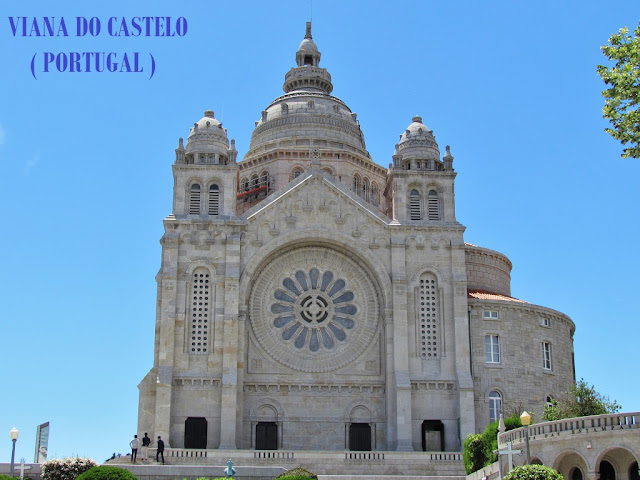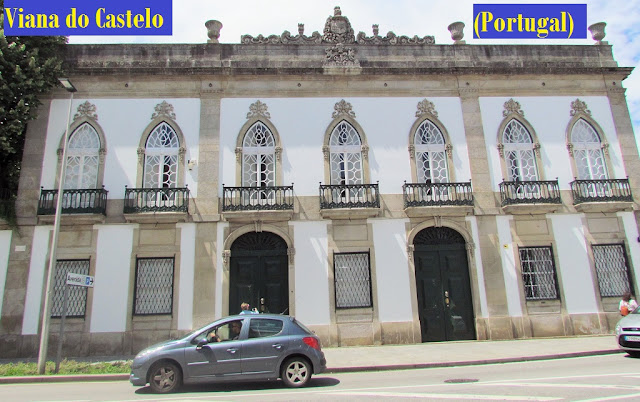VIANA DO CASTELO
GPS: N 41.70135; W 8.83502
Viana do Castelo is a Portuguese city, capital of the district with the same name, in the North region, and integrated in the NUT III sub-region of Alto Minho, with about 26 000 inhabitants (2021).
It is the seat of the Municipality of Viana do Castelo, which has an area of 319.02 km² and 85,784 inhabitants (2021) and is subdivided into 27 parishes. The municipality is limited to the north by the municipality of Caminha, to the east by Ponte de Lima, to the south by Barcelos and Esposende, and to the west by the Atlantic Ocean.
The highest point in the municipality is in Serra de Arga, more precisely in Alto do Espinheiro, at 825 meters above sea level.
It belongs to the network of Cittaslow Towns and to the Portuguese Network of Healthy Cities.
History
Human occupation of the Viana region dates back to the Mesolithic, as witnessed by numerous archaeological finds (prior to the pre-Roman citadel) on Monte de Santa Luzia.
The village of Viana had received a Charter from Afonso III of Portugal on July 18, 1258, having been renamed Viana da Foz do Lima. Due to the prosperity acquired since then, Viana became an important trading post, and a defensive tower was built (Torre da Roqueta) with the function of repelling pirates from Galicia and North Africa, who were looking for this port.
The thriving maritime trade with northern Europe involved the export of wine, fruit and salt, and the import of cutlery, fabrics, tapestries and glassware. Viana's commercial spirit reached such proportions that Queen Maria II of Portugal granted a charter to the extinct Commercial Association of Viana do Castelo in 1852. The same sovereign - to reward the loyalty of the population of Viana, which had not surrendered to the forces of the Count Antas (1847) — decided to elevate the village to the category of city with the name of Viana do Castelo (January 20, 1848). In the 20th century, it became one of the main Portuguese cod fishing ports.
Climate
Viana do Castelo has a Csb-type Mediterranean climate, that is, with mild summers. Days with more than 30ºC occur relatively rarely, around 20 per year on average, and summers are relatively dry, but one of the wettest in mainland Portugal. Winters are mild and very rainy, with days below 0°C rarely occurring, around 10 per year.
Parishes
The municipality of Viana do Castelo is divided into 27 parishes:
Afife
Alvarães
Amonde
Anha
Areosa
Barroselas e Carvoeiro
Cardielos e Serreleis
Carreço
Castelo do Neiva
Chafé
Darque
Freixieiro de Soutelo
Geraz do Lima (Santa Maria, Santa Leocádia e Moreira) e Deão
Lanheses
Mazarefes e Vila Fria
Montaria
Mujães
Nogueira, Meixedo e Vilar de Murteda
Outeiro
Perre
Santa Marta de Portuzelo
São Romão de Neiva
Subportela, Deocriste e Portela Susã
Torre e Vila Mou
Viana do Castelo (Santa Maria Maior e Monserrate) e Meadela
Vila de Punhe
Vila Franca
Economy
Home to a modern service based economy, the city, along with its region, has a seaport with naval repairing facilities. Its major industries are related to naval construction and repair, with the Estaleiros da Viana do Castelo remaining one of the few large shipyards still in operation. Home to a large cluster of wind green electricity and car-parts industries it has become one of the most dynamic exporting regions in the country.
Architecture
Civic
Since the early 1990s the city started a wide urban renewal plan, pioneering the "Polis program", and including enlarging the pedestrian areas, building new modern architecture and creating new public spaces and parks. Architects such as Siza Vieira, Eduardo Souto de Moura and Fernando Távora have participated in the construction of a modern, well preserved and lively city center.
Geraz do Lima carriage museum
Renaissance fountain (1535) in the Major Square
Palacio de Tavoras, a noble residence from the 16th and 17th centuries
Municipal Museum, housed in an 18th-century building and home to
Paços do Conselho ("Palace of the Council", 1502), of which only the façade remains today
Religious
Church of Sâo Domingos (1576)
Chapel of the Holy Family (Portuguese: Capela da Sagrada Família e Portal da Quinta dos Espregueira)
Chapel of Our Lady of the Agony (Portuguese: Capela de Nossa Senhora da Agonia), church in Roccoco style
Cathedral of Viana do Castelo (Portuguese: Igreja Matriz de Viana do Castelo/Catedral de Viana do Castelo/Sé de Viana do Castelo), the 15th-century parochial church and cathedral, was constructed in the Romanesque style, comprising a façade flanked by two large towers with merlons, while the middle Gothic portal with archivolts is decorated by sculptures depicting the Passion of Christ and of the Apostles. The interior designed in the form of the Latin cross, includes a nave and two aisles (separated by arches supported by pillars), as well as two ancillary chapels dedicated to São Bernardo and the Holy Sacrament.
Church of Mercy of Viana do Castelo (Portuguese: Igreja da Misericórdia de Viana do Castelo), designed in the Flemish-style. The building dates back to 1589.
Sanctuary of Saint Lucy (Portuguese: Santuário de Santa Luzia), designed by Miguel Ventura Terra and dedicated to the cult of the Sacred Heart of Jesus and Saint Lucy of Syracuse.
Sanctuary of Monte de Santa Luzia (Basilica)
The architectural typology is Romanesque-Byzantine inspired. Its imposing rosettes are the largest in the Iberian Peninsula and the second largest in Europe.
You can climb to Monte de Santa Luzia using a funicular (elevator), car, or via a staircase. From this location, an important part of the Lima River Valley is dominated and a large part of the seafront, north, and south of the river estuary, as well as the verdant mountain range. This panorama was considered by National Geographic Magazine as the 3rd most beautiful in the world.












💓💓💓💓💓💓💓💓💓





















Church of the Mercy (IGREJA DA MISERICÓRDIA)
The building, from 1589, is a unique example of Renaissance and Mannerist-inspired architecture, with Italian and Flemish influences.
Inside, the church has a great decorative richness corresponding to the trend of the time, whether in the gilded altarpieces in national style, either in the tile covering, or the frescoes on the ceiling. It is undoubtedly one of the best Baroque examples in the whole country.






GIL EANNES (SHIP)
Gil Eannes is a former Portuguese hospital ship, now permanently moored in the Port of Viana do Castelo, serving as a museum ship and youth hostel.
Between 1955 and 1973, Gil Eannes was the flagship of the Portuguese White Fleet that operated in the codfish fishing in the seas of the Grand Banks of Newfoundland and Greenland. As the flagship of the White Fleet and besides her main function as a hospital ship, Gil Eannes served also as a maritime authority, mail ship, tug, icebreaker, and general support ship for the Portuguese fishing vessels.

💓💓💓💓💓💓💓💓💓

💓💓💓💓💓
SEARCH IN ALPHABETICAL ORDER
IN THE DISTRICT OF VIANA DO CASTELO
Paredes de Coura;
Peneda-Gerês National Park;
Ponte da Barca;
Ponte de Lima;
Sistelo;
Soajo;
Valença + Tui - Tuy (Spain);
VIANA DO CASTELO;
Vila Nova de Cerveira;
Vila Praia de Ãncora;
Peneda-Gerês National Park;
Ponte da Barca;
Ponte de Lima;
Sistelo;
Soajo;
Valença + Tui - Tuy (Spain);
VIANA DO CASTELO;
Vila Nova de Cerveira;
Vila Praia de Ãncora;
💓💓💓💓💓
Return to mainland Portugal &
the Azores and Madeira islands



































































